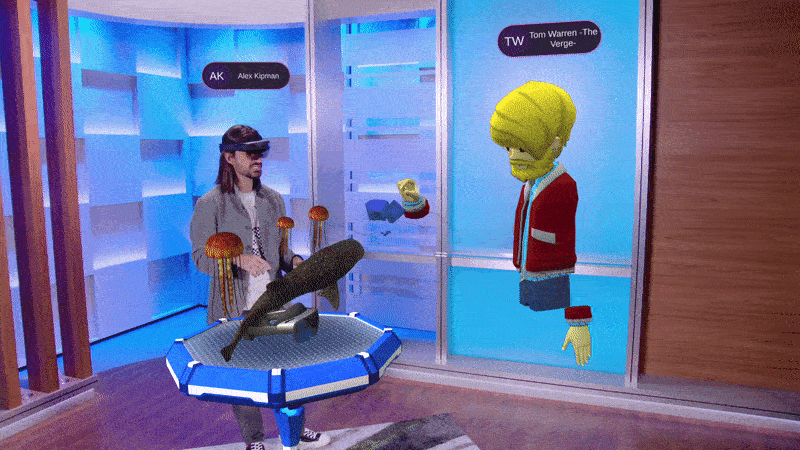Last week, Microsoft’s Alex Kipman, the inventor of Kinect and HoloLens, appeared in my living room to hand me jellyfish and sharks. That might sound like I had a weird dream, but it was a meeting made possible through Microsoft’s new Mesh platform. I donned a HoloLens 2 headset, joined a virtual meeting room, and Kipman immediately appeared next to my coffee table, ready to demonstrate Microsoft’s vision for the future of VR and AR — or as Microsoft calls it, mixed reality.
It all felt like a Microsoft Teams meeting set in the future.
Mesh is a collaborative platform that allows anyone to have shared virtual experiences on a variety of devices. “This has been the dream for mixed reality, the idea from the very beginning,” explains Kipman. “You can actually feel like you’re in the same place with someone sharing content or you can teleport from different mixed reality devices and be present with people even when you’re not physically together.”
Initially, Mesh will present people as virtual avatars taken from the AltspaceVR social network that Microsoft acquired back in 2017. Mesh will eventually support what Microsoft calls “holoportation,” allowing people to appear as themselves in a virtual space.

During my hour-long meeting in Microsoft Mesh, I constantly felt like this could be a far-future version of Microsoft Teams. Kipman appeared next to me as an avatar and started handing me virtual jellyfish and sharks. I could reshape the animals, pass them back, or just place them down in front of me. Although we weren’t working on some grand design or 3D model, it felt far more immersive than the Zoom video calls I have to attend on a near-daily basis.
It was the next best thing to having Kipman in the room with me and reminded me of my first experience with HoloLens. Microsoft originally demonstrated HoloLens using a collaborative Skype call where a technician could guide you on how to fix some wiring. It felt like the promise of augmented reality, and Microsoft Mesh seems like the natural next step.
“You can completely imagine a Mesh-enabled Microsoft Teams, where the key thing there is, think about colleagues from across the globe collaborating as if you and I are in the same physical location,” says Kipman. “Mesh enables Teams to allow organizations to essentially do mixed reality gatherings with everyone in the same room and so you should think about that in a Mesh-enabled Teams-type of an environment.”
:no_upscale()/cdn.vox-cdn.com/uploads/chorus_asset/file/22339282/Do2MlsI.jpg)
Mesh isn’t just an app for holding virtual meetings, though; it’s an entire platform built on top of Azure that Microsoft hopes developers will tap into. Microsoft is hoping architects, engineers, and designers will all see the promise of Mesh, particularly during a pandemic when it’s difficult to work with 3D physical models without all being in the same room.
Microsoft is also making Mesh available on a variety of devices, including the HoloLens 2, most virtual reality headsets, tablets, smartphones, and PCs. A preview of the Microsoft Mesh app for HoloLens 2 will be available today, alongside a preview version of AltspaceVR that is Mesh enabled. Microsoft is planning to integrate Mesh into Teams and Dynamics 365 in the future, which might help bring the unique meeting experience I had into a reality for more people.
Microsoft certainly thinks Mesh will be the next big thing for mixed reality. CEO Satya Nadella compared the new platform to Xbox Live during his keynote speech at Ignite today. “Think about what Xbox Live did for gaming — we went from single player to multiplayer, creating communities that helped people connect and achieve together,” said Nadella. “Now just imagine if the same thing happened with mixed reality.”
:no_upscale()/cdn.vox-cdn.com/uploads/chorus_asset/file/22339287/cameron.png)
The big thing holding Microsoft Mesh back is the cost of HoloLens devices and VR headsets. While you can jump in from a 2D screen like a phone or PC, it’s nowhere near as immersive as using a headset. Microsoft has tried to bridge this gap in the past with ambitious projects like Minecraft Earth, offering AR experiences on mobile phones. That particular project didn’t work out, and it’s not clear whether Microsoft Mesh will strike a chord with users either.
Microsoft Mesh will need some strong developer support or offer experiences you just can’t get anywhere else in VR to pick up momentum. Microsoft has recruited filmmaker James Cameron, Pokémon Go developer Niantic, and the co-founder of Cirque du Soleil to demonstrate the promise of Mesh during its Ignite keynote today.
A proof-of-concept version of Pokémon Go running on the HoloLens 2 and virtual concerts certainly show what’s now possible with Microsoft Mesh. The reality will now depend on the popularity of headsets or Microsoft’s ability to market this new technology toward businesses looking to embrace hybrid ways of working as the world navigates its way out of a pandemic.
Update, February 2nd 11:40AM ET: Article updated with comments from Microsoft CEO Satya Nadella.
Article From & Read More ( Microsoft Mesh feels like the virtual future of Microsoft Teams meetings - The Verge )https://ift.tt/3e5L5lx
Bagikan Berita Ini














0 Response to "Microsoft Mesh feels like the virtual future of Microsoft Teams meetings - The Verge"
Post a Comment